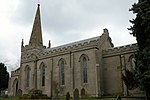Hartlebury railway station
1852 establishments in EnglandDfT Category F2 stationsFormer Great Western Railway stationsPages with no open date in Infobox stationRailway stations in Great Britain opened in 1852 ... and 4 more
Railway stations in WorcestershireRailway stations served by West Midlands TrainsUse British English from December 2017West Midlands (region) railway station stubs

Hartlebury railway station serves the village of Hartlebury in Worcestershire, England. All trains serving the station are operated by West Midlands Trains. The station is unstaffed and is about half a mile to the east of the village. Hartlebury is the least-used station in Worcestershire.
Excerpt from the Wikipedia article Hartlebury railway station (License: CC BY-SA 3.0, Authors, Images).Hartlebury railway station
Flugplatzstraße,
Geographical coordinates (GPS) Address Phone number Website Nearby Places Show on map
Geographical coordinates (GPS)
| Latitude | Longitude |
|---|---|
| N 52.334 ° | E -2.221 ° |
Address
On Top - Das Flugplatzrestaurant
Flugplatzstraße 2
95463
Bayern, Deutschland
Open on Google Maps








